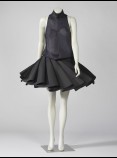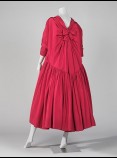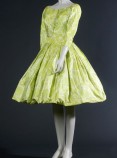1930–1960


Dress. Pedro Rodríguez (1895-1990) Barcelona. 1940-50. Silk satin embroidered with sequins. Donated by Pedro Rodríguez, 1986. MTIB 146160

Dress. Pedro Rodríguez. Barcelona. 1949-50 Silk satin (duchess satin) embroidered with rhinestones, mother-of-pearl and glass beads, cotton taffeta flower. Pedro Rodríguez / MADRID / BARCELONA / S. SEBASTIÁN. Donated by Hilda Bencomo, 2007. MTIB 3269/07.

Coat dress. Spring-summer collection 1955. Cristóbal Balenciaga (1895-1972). Barcelona. 1955. Faille silk. Label: EISA. Donated by Sra. Carmen Mateu de Suqué, 1977. MTIB 104656


Haute Couture. The artificial silhouette
In the years of the Spanish Civil War and World War II, clothes reflected the grim times, economic uncertainty and conservatism in Europe.
Dresses evolve from the fluid forms of the 1930s to the austere 1940s, influenced by military uniforms, and then to the hourglass silhouette highlighting the symbols of femininity.
Day dresses remain short, while gowns for evening wear and parties are long. In the 1950s, lingerie accentuates pointed breasts and curving hips.
Men wear three piece suits with a hat.


